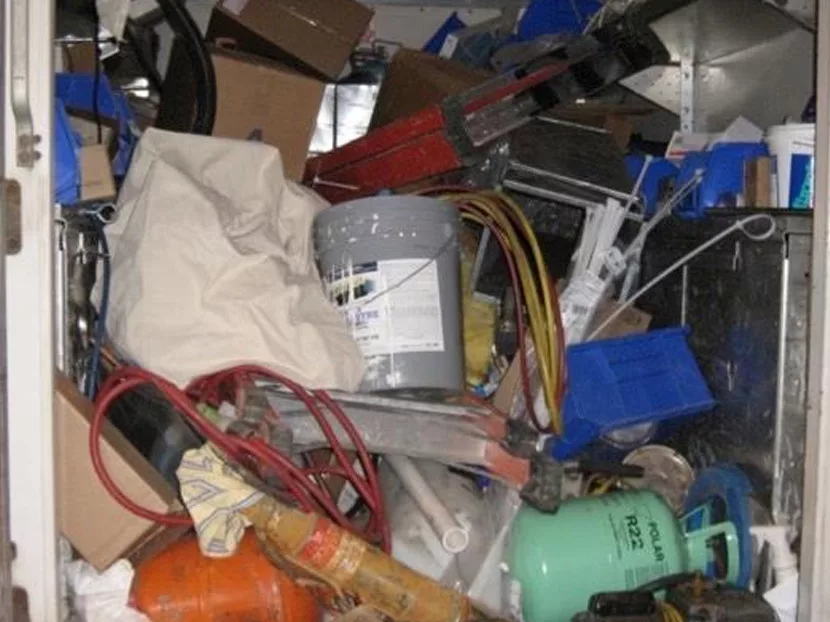Could your shop use some tidying up? Are you knee-deep in obsolete inventory? Do you have papers on your desk from the 1970s? Do you have trucks that look like the one pictured with this column?
Perhaps it’s time to put your shop in order. In her best-selling book, The Life-Changing Magic of Tidying Up, Marie Kondo suggests that you “start by discarding. Then organize your space, thoroughly, completely, in one go.”
In other words, rip off the bandage in one pull. Clean your shop and do it all at once. If you do, you’ll only have to tidy up once. From there on, it will just be a matter of putting things where they belong.
If you limp along, however, taking a box at a time to Goodwill, you’ll not only never get it done (have you?), but you’ll miss the powerful, positive effect of the almost instant transformation.
Imagine that moment: hours before, it was a hot mess and now you are standing in a fully organized shop. Only the things required to serve customers and make money remain. Those things are in their place, at the ready to be used and replaced as needed.
The space feels open. The air smells sweeter. It’s all … lighter. And it hits you in the gut and the heart and you want more. That’s the transformative moment with the power to change your behaviors. Clearing clutter in bits and blobs just doesn’t do it.
And this isn’t just about you. It’s about your team.
Suppose a U.S. veteran applies for a job at your shop. Here is a person who understands procedure and holding to standards. Your tip-top shop indicates that the professionalism learned in military service will be supported and rewarded. You’ll be seen as a person of integrity when you share your vision and mission, when you send this message across your tidy desk in an executive-level office.
It’s also about your customers.
When they stop by your shop, your commitment to order and organization contributes to their good opinion of you. When they peer into your trucks, you appear disciplined and professional, as if you know what you’re doing and you have what you need. They know to expect premium service at premium prices. What does a mess communicate to them?
You have a choice. You can live with the mess. Or you can tidy up. Your office and shop don’t have to be glamorous. They just have to be clean and orderly.
Kondo’s book is written specifically to help you organize your home, not your business. So, I am making some suggestions here that may not appear in the book. Just sayin’.
Digging in
The tidy-up is a project, so elevate it. Put “Total Company Tidy-Up” on your Top Projects list. Define and delegate tasks in the project by asking and answering the journalistic questions: What are we doing? Why? When?
Discuss who will be in charge of the project and who can help. There may be a tidy person on the team who is happy to be the lead and already may have embraced the Kondo Method! Family, friends, interns, volunteers, as well as team members could participate. (Of course, you want to have your legal t’s and i’s handled, and arrange for people to formally work for you throughout the cleanup.) You could hire subcontractors, too, or people from a temp agency.
If you are the owner, the items in the business are your things. You get to decide what stays or goes. If you are a co-owner, you can start with your office, your spaces and your things. Demonstrate some dramatic results and you may magnetize the other owner/s to accept your help.
“The urge to point out someone else’s failure to tidy is usually a sign that you are neglecting to take care of your own space,” Kondo says
Here are some tips:
• Pick a Saturday or Sunday. You may need two days. You may need more. And don’t stop until the job is done. And it is done when everything is in its place.
• Create the discard piles. Arrange for a dumpster to be placed in the yard. Set up areas, or containers, for scrap and other recyclables. Create a pile to be returned for credit to the supply house. Set up a place to put items for donation.
• Pull everything out and off of shelves, drawers and closets in the shop, office and trucks.
• Put similar items — categories — together. Categories may be inventory (you can create subcategories such as equipment, pipe, fittings, valves, controls, consumables), tools, office supplies, educational material, decorative items and memorabilia.
• Organize by category, not by room. This may be the most important tenet of the Kondo method. If you do a room or an area at a time, you may not realize you are storing the same items in multiple places. You might have copy paper stashed in 10 closets throughout the building.
• Go through a category at a time. Decide! What goes? “There are only two tasks when tidying: discarding and where to keep things,” Kondo says. “Just two but discarding must come first.” So often, I have seen tremendous cleanup efforts wasted because the finished project is just the same stuff stacked better.
• As you go through each category, only keep things required to do your work to your standards. Discard damaged or obsolete inventory. Office supplies — how many perfectly good pens that you don’t like do you need? (Answer: none.) Can you access educational material on the Internet? Donate the hard copies or recycle.
• The category list is helpful as you want to start with the piles that are not emotional ticking bombs. Go through the memorabilia last. If you start with this pile, you’ll be crying and laughing and nothing will get done!
• Even with memorabilia, be aware that the memories are not limited to holding on to the items. “Keep only those items that spark joy,” Kondo says. You may create a place to display a few items telling the story of the family business. You could have a Wall of Pride or a small family museum. Some items can be loved and still discarded.
• When the discarding is complete, you can find spaces for what you’ll keep. Imagine how much room you’ll have to organize the remaining items: the items you need and a few you love. Remember to organize by category and keep similar things together. Shelving is your friend! Don’t pile things on top of one another.
• Yes, you will regularly need to restock consumables and inventory. Do you have procedures for doing so? If not, put it on your Master Projects list and elevate it to Top Project status when you get the tidying done.
• Have the discard piles picked up before you and your crew can dig through them again.
What if you just … can’t?
I used to think a chronically messy shop was the result of an owner who was just too busy or distracted to address it. Sometimes that is the case and the strategies listed above should suffice.
However, sometimes stuff accumulates because you can’t part with it. The emotional strings are too strong. Or there is a deeper psychological issue. You may need the help of a professional organizer. Check out the National Association of Professional Organizers (www.napo.net). Feel as if you might need even more help? You could seek the help of a therapist who specializes in hoarding.
Tidy up your shop and do it all at once. Remember, you’ll never have to do this again. From this point on, you need only put things back or replace the items you use. Take it as a challenge. If you and your team can do this, you can do anything.
I’m throwing down the glove. Your task is to discard the glove or put it where gloves belong.






